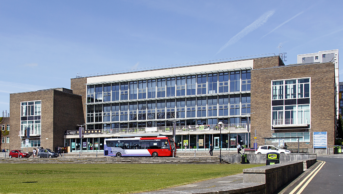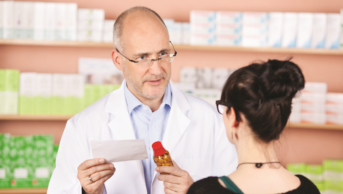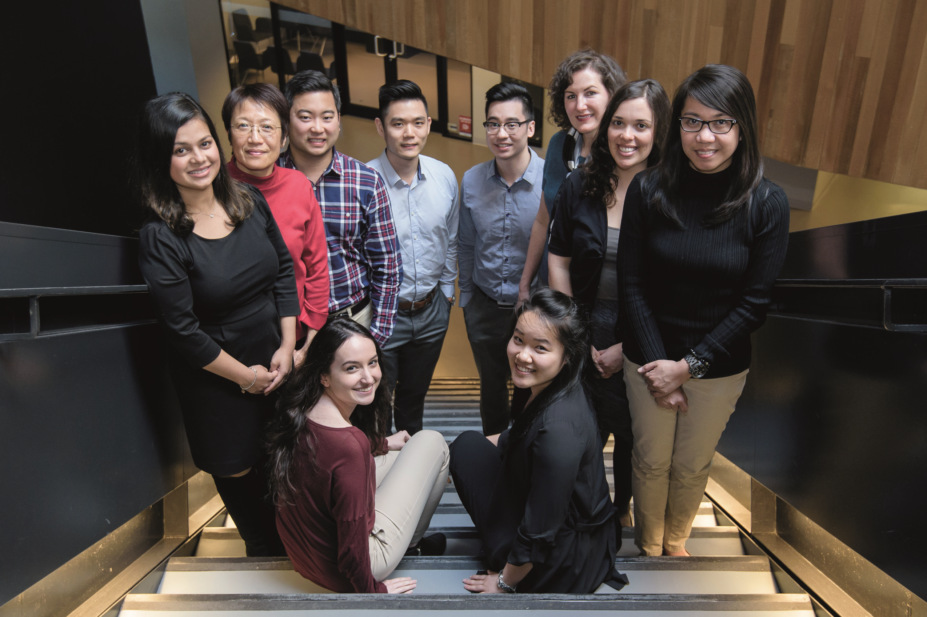
Courtesy, Pharmacists Clinic
A man in his 40s arrived at the Pharmacists Clinic, a pharmacist-led primary care clinic at the University of British Columbia (UBC), after ten years of living with debilitating, chronic pain following a car accident. By this point, he had already been under the care of multiple doctors and had been prescribed in the region of 20 medicines.
“He wasn’t able to walk or eat properly, and was gaining a tonne of weight,” says Larry Leung, a clinical pharmacist and lecturer at UBC, who has a leading role in the clinic.
“His was one of those classic polypharmacy cases where … nobody takes a step back to look at all the medications as a whole,” explains Leung.
Over the course of three years at the clinic, Leung recommended a streamlined medicines regimen to target the source of the man’s pain more effectively. Now, he takes around ten medicines and has started exercising and doing physical therapy, resulting in him losing around 40 pounds in weight. “Seeing the progression was really rewarding,” says Leung.
Working closely with patients in a primary care setting is central to the objectives of the clinic. Established in 2013, the Pharmacists Clinic at UBC was created for three reasons, explains director Barbara Gobis: first, to showcase what pharmacists are capable of and to develop well-tested models of best practice; second, to be a site where pharmacy students at UBC come to learn; and finally, to be a ‘living laboratory’, where research is carried out by the university.
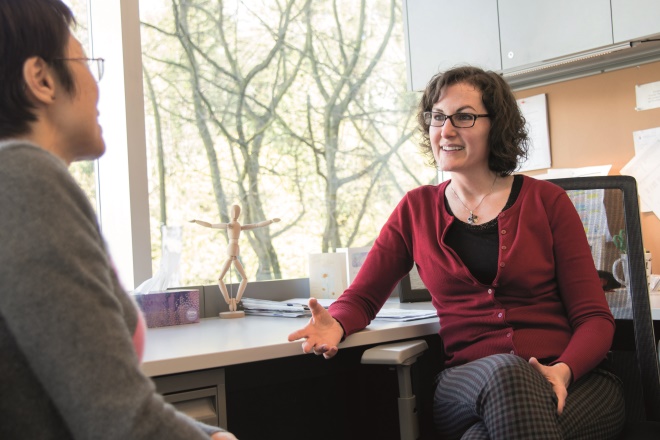
Source: Courtesy, Pharmacists Clinic
Barbara Gobis, director of the Pharmacists Clinic, says the University of British Columbia felt that it had a leadership role to play in developing new practice models and stimulating positive change in the profession
The clinic is run solely by pharmacists, but does not dispense or supply medicines; pharmacists provide patients with consultations free-of-charge, which last for up to an hour, in order to review and help manage their medicines. The model shares elements with the way pharmacists in GP practices work in the UK, but with a unique focus on research and teaching. It seems that little is known about the initiative among pharmacy academics in the UK. Some of those approached by The Pharmaceutical Journal were enthusiastic about the idea, describing it as “fantastic”, while others were more cautious, raising questions about whether such a scheme, which is unique both inside and outside of Canada, would translate to the UK.
The results of the clinic’s first research study, which began in September 2015, are yet to be released and it remains to be seen whether the model will be adopted elsewhere.
Establishing the clinic
The idea for the clinic was first mooted back in 2010 by a few members of the faculty of pharmaceutical sciences at UBC. At the time the department was planning to move to a brand new building, to increase the number of students and to change the undergraduate programme from a bachelor of science (BSc) to a doctor of pharmacy (PharmD) degree — a course that requires two prior years of basic science, instead of one, and includes more clinical education and hands-on experience with patients. This coincided with a shift in focus to clinical pharmacy care in Canada. “It presented the opportunity to do something a bit different,” says Michael Coughtrie, dean of the faculty of pharmaceutical sciences at UBC.
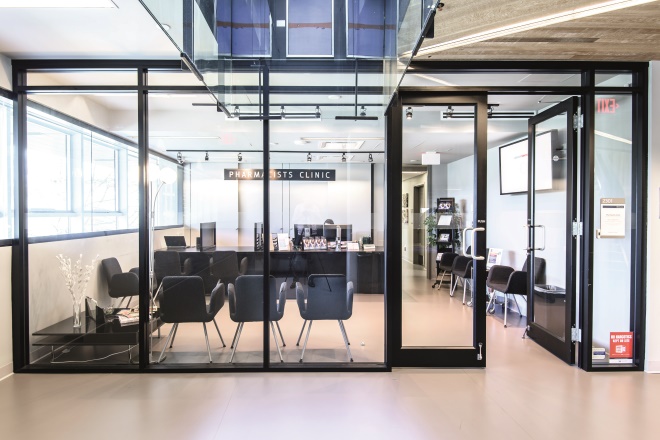
Source: Courtesy, Pharmacists Clinic
The Pharmacists Clinic is run solely by pharmacists but does not dispense or supply medicines; pharmacists provide patients with consultations lasting up to an hour in order to review and help manage their medicines free of charge
According to Gobis, who was brought in to develop and implement the clinic in April 2013, the faculty was keen to address the fact that the practice systems and processes out in the field were lagging behind pharmacists’ training. In Canada, as in the UK, the role of drug therapy “is extremely prominent”, she says. Medicines represent the second largest expense to the Canadian health system and Gobis says that there is a recognition that pharmacists are needed to help manage increasingly complex drug regimens. To reflect this, the curriculum at UBC had already become more clinical but the work pharmacists were doing had not caught up, she explains.
“The university felt that it had a leadership role to play in developing these new practice models and to stimulate positive change in the profession,” she says. It was this that ultimately led the faculty to realise it needed a living laboratory, and so space for the clinic was built into the designs for the new pharmacy school building.
After a successful soft-launch in November 2013, the clinic officially opened in April 2014. In its first full financial year, ending in 2015, a total of 1,460 patients came through the doors. Now, the clinic sees more than 2,000 patients and teaches more than 100 students each year, with a staff of 4 pharmacists running the clinic day to day.
Patient care on campus
Unusually for a pharmacist in Canada, Leung specialised in primary care after graduation and was teaching at UBC when he was asked to work with Gobis to help plan the clinic. The system of patient care has now been in place for three years.
“Usually, when the appointment has been made we will receive a consultation report of the patient and then, prior to the patient coming in, we’ll pull up their PharmaNet profile, which is the provincial record of all their medications,” he explains.
Gobis says that gaining access to PharmaNet, which has been running in British Columbia for 22 years, was one of the more challenging moments while starting the clinic. In order to connect, the clinic needed to be licensed in the same way that community pharmacies in British Columbia are.
Leung says that the database usually provides some “good information”. This is checked against the doctor’s report (if one has been sent), and the medicines record is updated — a job, Leung says, that is usually carried out by a student.
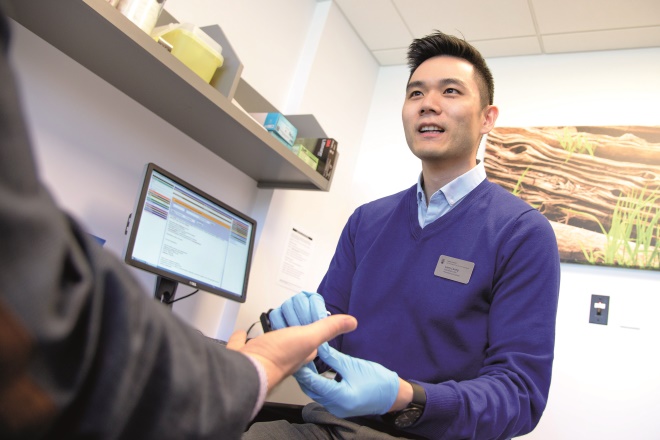
Source: Courtesy, Pharmacists Clinic
Larry Leung, a clinical pharmacist and lecturer at the University of British Columbia, says that the clinic focuses on “shared, informed decision making” and will often present various options to the patient before making a recommendation
Two-thirds of the patients who come to the clinic are referred by a doctor and the other third are either self-referrals, pharmacist referrals or hospital referrals. One neurologist sends all of her migraine patients to the clinic before seeing them so that the clinic can “sort out everything with the drug therapy and then her job is easy after that”, says Gobis. “We don’t turn anyone away if there’s a need,” she adds.
While at the clinic, each patient receives a full assessment, including family history, medicines, natural products and immunisations. Leung says that the clinic focuses on “shared, informed decision making” and will often present various options to the patient before making a recommendation. Many patients at the clinic are suffering with chronic pain and taking high-risk medicines, and so they are given a stepwise tapering plan and are followed up with telephone calls. This kind of support is “not really something that exists” in the wider health system, adds Leung.
Marjorie Weiss, head of the school of pharmacy at Cardiff, says that her only concern about the clinic is the connection between its pharmacists and the patient’s other healthcare providers but that, “provided they’re part of a team, I think it’s great”. Leung explains that, after the consultation, the clinic sends a report to the patient’s doctor and their community pharmacist. “Looping [their community pharmacist] into that circle of care is really important because they can help follow up with certain aspects,” says Leung.
The potential for campus pharmacies in the UK
Donald Cairns, head of the school of pharmacy at Robert Gordon University in Scotland, believes that the model is exciting and “quite innovative”, and he would like to see more of it. He adds that this unique model of practice shows that “pharmacy has a number of different futures”.
It’s exciting and I’d like to see more of it
Cairns says that he has worked at universities in England that have looked at opening campus pharmacies and even reached the stage of working up plans, but decided not to proceed for various financial reasons.
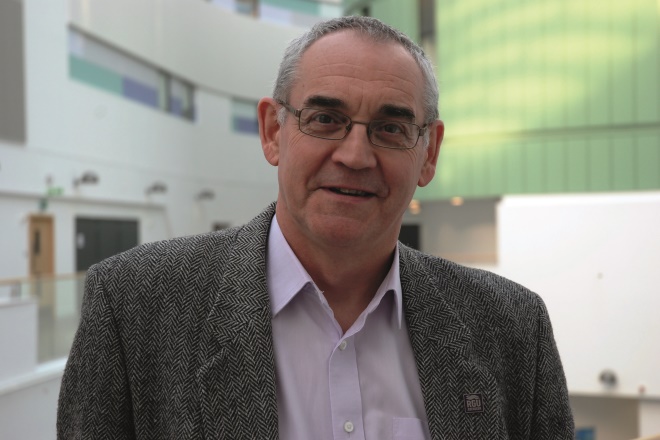
Source: Courtesy of Donald Cairns
Donald Cairns, head of the school of pharmacy at Robert Gordon University in Scotland, describes the Pharmacists Clinic model as “exciting” and says he would like to see more of it
At UBC, the clinic is financed through a number of channels. Salaries for clinic staff are paid by the university and consultations with patients are partly paid for by the government, which allows pharmacists to bill for medication reviews. Services such as vaccinations also bring in some revenue. Coughtrie says that there was no specific grant from the government and not all the costs are offset, but he adds that “if you want to be the best [pharmacy school] you’ve got to push forward”.
Weiss believes that a similar model would definitely be desirable in a UK pharmacy school.
“As a training opportunity for students it’s wonderful,” she says.
According to Weiss, a number of schools are looking at different models of care and trying to place students in roles that are different from the traditional dispensing model. But one of the questions around bringing a Pharmacists Clinic-style model to the UK is that of funding.
“I think it’s possible, but funding is always going to be difficult,” she says.
I think it’s possible, but funding is always going to be difficult
However, she remains optimistic, saying that the NHS already provides funds for students to be mentored by NHS staff, which shows collaboration is possible.
Paul Grassby, head of the school of pharmacy at Lincoln University, points out that pharmacy degrees in the UK are funded as science degrees, unlike medicine or dentistry, so do not receive supplements to fund clinical teaching and experience within the degree.
To get around this, he says, the pharmacy school at Lincoln reaches out to patient groups, who send patients to the university for educational purposes so that students can practise conducting consultations and making a care plan. But Grassby is sceptical about transposing this training into a service offered to the public in the UK.
“How do you attract patients? What would be their motivation for coming in?” he asks. With the recent push to get more pharmacists into GP practices, a patient may already be getting a similar service to what would be offered by a campus. Grassby also wonders why a patient would go to a clinic on a university campus when they could go to a healthy-living pharmacy on the high street and have a medicines use review.
“While I can understand the benefit to the student, I’m just trying to get my head around what the benefit is to the patient,” he adds.
A learning tool for pharmacy students
At UBC, students are a big part of the work that the clinic does. Third- and fourth-year students can do four- or six-week placements at the clinic and graduate pharmacists often come to complete a certificate, or as part of their residency programme. Often, students will get to practise leading consultations and making recommendations to patients under the supervision of the clinic’s pharmacists.
Consultation rooms even have video cameras installed so that students can be on their own with patients while a supervisor observes from a ‘hub room’. “It’s a great learning tool,” says Leung.
Students also get to accompany the supervisors off-site. A number of staff run clinics at GP surgeries either monthly or fortnightly — a model now familiar to pharmacists in the UK. The off-site consultations are run in a similar way to those at the campus clinic but they involve the patient’s doctor, who is brought in for the last 15 minutes of the appointment.
“[The students] really love it because they get a chance to talk to physicians, or there might be medical students and they can work together and review the patient,” says Leung.
Terin Lovesar, a pharmacy student in the fourth year of her degree at UBC, says sitting in on consultations is “inspiring”. “All [of the supervisors] have their different ways of communicating and building rapport and seeing this process in action is invaluable,” she says.
All [of the supervisors] have their different ways of communicating and building rapport and seeing this process in action is invaluable
Lovesar has been involved with the clinic since her second year of study and now plays a key role as a student employee, assisting the team with the clinic’s research project, CAMPUS (Cardiovascular Assessment and Medication Management by Pharmacists at the UBC Site). The aim of the study is to assess whether pharmacists can help patients to improve their cardiovascular risk factors. Lovesar is responsible for inputting the data for the study and ensuring patients are not lost to follow-up. She has also been enlisted to help write part of the manuscript.
When the study began in September 2015, 510 faculty members and staff came forward for heart health screening, and 209 had cardiovascular risk factors.
According to Gobis, the idea is for pharmacists at the clinic to provide a standard service where they coach, monitor and help patients to reduce their cardiovascular risk. The clinic has followed patients for a year and around 160 have already completed the study. The goal is to measure whether risk factors went down, patients’ quality of life went up and if they feel “empowered”. Gobis explains that the study is part of a broader plan focussed on “using what we’ve built and leveraging it in support of the academic programme … pharmacists in practice and … a robust pharmacist research programme”.
Rachel Joynes, head of research and evaluation at the Royal Pharmaceutical Society at the time of interview, believes that, in terms of research, “it is a good model” because it brings together a critical mass of patients and healthcare professionals to do the research. “For me it’s about rigour, and experts in the university provide that,” she says. However, she is unsure whether something similar is required in the UK.
Although official results for the study are not yet available, it seems that the work has already had a positive impact on the students at the clinic. Lovesar says that assisting the research project has been her most rewarding experience at the clinic. Overall, she says that being part of the Pharmacists Clinic has given her more confidence to tackle new projects because the team has been extremely supportive and given her a safe environment to try new things. In the future she says that she hopes to work in primary care.
So perhaps the real success of the clinic has been in moulding new pharmacists who take the profession forward by providing confident clinical care, and Lovesar certainly seems to embody this idea.
“I get so excited because I do want to practise in a clinical sense, after seeing everyone here do it, and getting to spend so much time with patients is really unique,” she says.
Reading this article counts towards your CPD
You can use the following forms to record your learning and action points from this article from Pharmaceutical Journal Publications.
Your CPD module results are stored against your account here at The Pharmaceutical Journal. You must be registered and logged into the site to do this. To review your module results, go to the ‘My Account’ tab and then ‘My CPD’.
Any training, learning or development activities that you undertake for CPD can also be recorded as evidence as part of your RPS Faculty practice-based portfolio when preparing for Faculty membership. To start your RPS Faculty journey today, access the portfolio and tools at www.rpharms.com/Faculty
If your learning was planned in advance, please click:
If your learning was spontaneous, please click:

